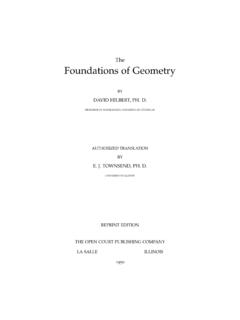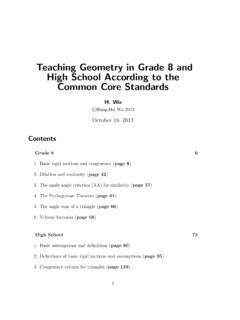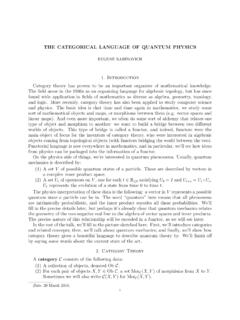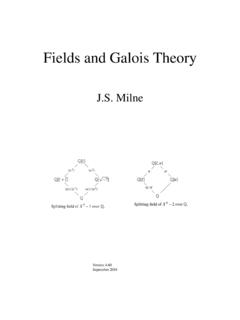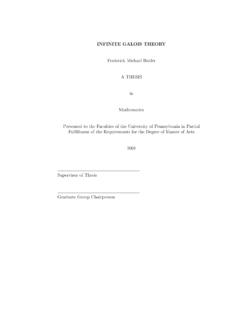Transcription of Galois Theory - math.berkeley.edu
1 Galois TheoryDavid CorwinAugust 19, 20090 PreliminariesRemark (Notation).|G|denotes the order of a finite groupG. [E:F]denotes the degree of a field extensionE/F. We writeH Gto mean thatHis a subgroup ofG, andNEGto mean thatNis a normal subgroup ofG. IfE/FandK/Fare two field extensions, then when we say thatK/Fiscontained inE/F, we mean via a homomorphism that assume the following basic facts in this set of notes, in addition to ele-mentary number Theory , group and ring Theory , and linear algebra:Fact a field, thenF[x] is a PID, so all nonzero prime ideals aremaximal and are generated by a single irreducible polynomial. This irreduciblepolynomial is the polynomial of lowest positive degree in the ideal and is uniquemodulo is an algebraic element in an extensionE/F, then the set of poly-nomials inF[x] which vanish at is a prime ideal generated by an irreduciblepolynomialf(x) (we can make this canonical by requiringf(x) to be monic),andF( ) =F[x]/(f(x)).
2 This polynomial is called theminimal polynomialof , as it has minimal positive degree in the ideal of polynomials vanishing at .Fact are isomorphic, and and are algebraic elements inan extension which have the same minimal polynomial under the isomorphism,then we can extend the isomorphism ofFandF to an isomorphism fromF( )toF ( ).Fact (Tower Law).IfE/KandK/Fare two field extensions, then [E:K][K:F] = [E:F].Fact set ofklinear homogenous equations over a field innunknownsforn > kalways has a nontrivial Splitting FieldsDefinition a field and supposef(x) F[x]. A field extensionE/Fis said to be asplitting fieldforf(x) overFif: (a) We can writef(x) =1(x a1)..(x an) inE[x]. That is to say,f(x)splitsoverE. (b) The elementsa1,..,angenerate the extensionE/F. Equivalently,f(x) splits in no (Uniqueness of Splitting Fields).
3 LetFandF be fields isomor-phic by . Then ifEandE are splitting fields forp(x)andp (x)respectively,wherep(x)is sent top (x)under , then there exists an isomorphism :E E which equals when restricted use induction on the numbernof rootsnofp(x) not inF. We canfactorp(x) asf1(x) fr(x) and similarlyp (x) =f 1(x) f r(x) where thefiandf iare irreducible, andfiis sent tof iunder the isomorphism ofFandF .Ifn= 0, thenE=F,E =F , so gives our desired the theorem forn kwherek 0. Suppose now thatp(x) hask+ 1 roots outside 0, there exists E Fwhich is a root ofp(x), say WLOGit is a root off1(x). Thenp(x) F( )[x], so sincep(x) splits inE, and itsroots generateEoverFand thereforeF( ), it follows thatEis a splitting fieldforp(x) overF( ). Similarly, if is a root off 1(x), thenE is a splittingfield forp (x) overF ( ). We can extend to an isomorphism ofF( ) andF ( ).
4 Then since lies inF( ) but not inF, the polynomialp(x) has at mostkroots outside ofF( ), and similarly forp (x), so we get an extension of theisomorphism ofF( ) andF ( ) to an isomorphism ofEandE , concludingthe an extension in whichp(x) F[x] splits, then thesubfield ofE/Fgenerated by all the roots ofp(x) is a splitting field forp(x)overF, and is hence isomorphic to any other splitting field forp(x).2 Group CharactersDefinition a group andFa field, then a homomorphism fromGintoF is called finite set of characters{ i:G F}1 i nis said to bedependentif there exist{xi}1 i nnot all zero such thatn i=1xi i(g) = 0for allg G. A set of characters is said to beindependentif they are finite set of characters{ i:G F}1 i nfrom a groupGinto a fieldFis they are dependent. We choose{xi}so that a minimal num-ber of thexiare nonzero, say WLOG the firstkof them, so that we have ki=1xk k= 0 wherek n.
5 Note thatk 2, or else 1(g) = 0 for 1and kare distinct, we can finda Gsuch that 1(a)6= k(a).Note that for anyg G, we haven i=1xi i(ag) =n i=1xi i(a) i(g) = also havek i=1xi k(a) i(g) = these equations, we getk i=1xi( i(a) k(a)) i(g) = gives us a dependence relation on our characters since 1(a) k(a)6= 0,but the coefficients of kbecomes 0, meaning this dependence relation hasfewer nonzero coefficients, a contradiction. It follows that our characters that an automorphism of of a fieldEis a character fromE follows from this theorem that a finite set of automorphisms of a field theorem will be very useful in establishing further Automorphisms and Degrees of ExtensionsDefinition 1, , nis a set of automorphisms of a fieldE, then thefixed fieldof these automorphisms is the set ofx Esuch that i(x) = j(x)for all 1 i,j n.
6 Note that if one of the automorphisms is the identity, thenFis the set ofx Esuch that i(x) =xfor all 1 i n. It s not too hard toshow thatFis a subfield a field, 1, , nis a finite set of automorphisms ofE, andFis the fixed field of the automorphisms 1, , n, then[E:F] that there exists a spanning set 1, , r EforEoverFwithr < n. Therlinear equations innunknownsx1 1( 1) + +xn n( 1) = 0 x1 1( r) + +xn n( r) = 03has a nontrivial solution inE. If =r i=1ai iwithai Fis an arbitraryelement ofE, thenn j=1xj j( ) =n j=1xj j(r i=1ai i)=n j=1r i=1xj 1(ai) j( i)=r i=1 1(ai)n j=1xj j( i)=r i=1 1(ai) 0= 0 But this means that these automorphisms are dependent overE, which is theorem also holds for an infinite set of automorphisms, since we canthen show that [E:F] is larger than any positive fixed by a set ofnautomorphisms, then[E:F] is the fixed field of those automorphisms, then [E:F] = [E:F ][F :F] (E/F)is the group of all automorphisms ofEwhich fixF, then|Aut(E/F)| [E:F].
7 From the theorem above, the best lower bound we can get is the order ofthe group of all automorphisms ofEwhich fixF. It turns out that this boundbecomes an equality. We prove the following:Proposition a finite group of automorphisms ofE, andFis thefixed field ofG, then|G|= [E:F]. { 1, , n}. We know that [E:F] n. Now supposethat [E:F]> n, so there is set 1, , r Eindependent overFwithr > the set ofnlinear equations inrvariablesx1 1( 1) + +xr 1( r) = 0 x1 n( 1) + +xr n( r) = 04has a nontrivial solution. We can assume WLOG thatx16= 0, and fur-thermore we choosex1to be anya E, since otherwise we could multiplyeverything 1 i,j n, we haver k=1xk i( k) = we fixj, then applying jto both sides of this equations givesr k=1 j(xk) j( i( k)) = iruns over all elements ofG, the expression j ialso runs over all elementsofG.
8 It follows that{ j(xk)}1 k rgives another solution to our system of linearequations. We can then setyk= G (xk),which will also be a solution to our equations. Furthermore, for 1 k r, if G, then (yk) =yk, soyk F. SinceGis a group, one of its automorphisms,say WLOG 1is the identity onE. Therefore,r k=1yk 1( k) =r k=1yk k= there existsa Esuch that G (a)6= 0 by the independence of auto-morphisms, so we could have chosenx1to be thisa. Theny16= 0, and wehave a dependence among the k, contradicting the assumption that they finite, andFis the fixed field of a groupGof auto-morphisms ofE, thenGis the set of all automorphisms ofEwhich have|G|= [E:F], and by Corollary , there are no more auto-morphisms Applications to Symmetric PolynomialsLetKbe a field, and letk(x1, ,xn) be the field of rational functions innvariables overK.
9 For each permutation of{1, ,n}, we get an automorphismofK(x1, ,xn) which sendsxitox (i)fori {1, ,n}. The fixed fieldSofthis group of automorphisms (isomorphic toSn) is called thefield of symmetricrational functions innvariables be the sum of all products ofk-tuples of thenvariables for1 k n. These are known as theelementary symmetric polynomials. Thenk(t1, ,tn) S K(x1, ,xn), so [K(x1, ,xn) :K(t1, ,tn)] |Sn|=n!.ButK(x1, ,xn) is the splitting field of the polynomialxn t1xn 1+ + ( 1)ntnoverK(t1, ,tn), which means that [K(x1, ,xn) :S] [K(x1, ,xn) :K(t1, ,tn)] n!, soS=K(t1, ,tn), and [K(x1, ,xn) :S] =n!.Now letSn=S, and defineSi=Si+1(xi+1) for 1 i n. It follows thatS1=K(x1, ,xn). We have the sequence of fieldsS=Sn Sn 1 S1=K(x1, ,xn).Lettk,idenote the sum of all products ofk-tuples of the firstivariables,x1, ,xi(sotk=tk,n).
10 Now suppose that a fieldFcontainsxi+1andtk,i+1for allk i+ 1. Thent1,i=t1,i+1 xi+1, and in general,tk+1,i=tk+1,i+1 xi+1tk,ifor 1 k i 1,soFcontainstk,ifor all 1 k i. More strongly,tk,ican be expressed as apolynomial overKinxi+1and all thetk,i+ we then induct downward oni, starting withi=n, we see thattk,icanbe expressed as a polynomial overKinxi+1, ,xnandt1, , t1,ixi 1i+ +ti,i= 0, andSiis fixed by thei! automorphisms ofK(x1, ,xn) which permute the firstivariables, the degree [K(x1, ,xn) :Si] =i!, and [Si:Si+1] =i+ well, sincexii t1,ixi 1i+ +ti,i= 0, we can express any power ofxiwith exponent at leastias a polynomial inxi,t1, ,tn, andxi+1, ,xnwhere the exponents ofxiare at mosti 1. If we have a general polynomialf K[x1, ,xn], we can first get rid of all powers ofx1with exponent at least1, then all powers ofx2with exponent at least 2, etc, until we get rid of allpowers ofxnwith exponent at leastn.

